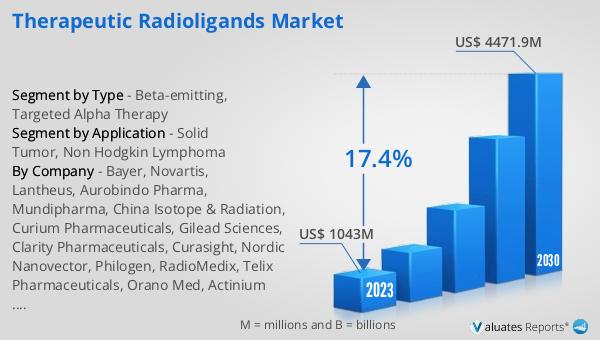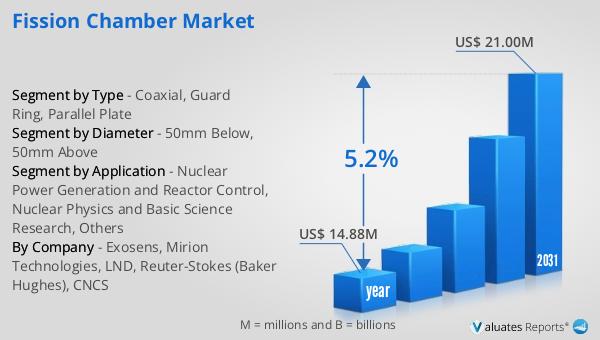What is Global Therapeutic Radioligands Market?
The Global Therapeutic Radioligands Market is a rapidly evolving sector within the healthcare industry, focusing on the development and application of radioligands for therapeutic purposes. Radioligands are a type of targeted therapy that combines a radioactive particle with a molecule that can specifically bind to cancer cells. This allows for precise delivery of radiation to the tumor, minimizing damage to surrounding healthy tissues. The market encompasses a variety of radioligands used in treating different types of cancers, including solid tumors and hematologic malignancies like Non-Hodgkin Lymphoma. The increasing prevalence of cancer, advancements in radioligand technology, and growing awareness about targeted therapies are key drivers propelling the market's growth. Additionally, collaborations between pharmaceutical companies and research institutions are fostering innovation and expanding the therapeutic applications of radioligands. As a result, the Global Therapeutic Radioligands Market is poised for significant growth in the coming years, offering promising new treatment options for cancer patients worldwide.

Beta-emitting, Targeted Alpha Therapy in the Global Therapeutic Radioligands Market:
Beta-emitting and Targeted Alpha Therapy are two prominent approaches within the Global Therapeutic Radioligands Market, each offering unique advantages in cancer treatment. Beta-emitting radioligands utilize beta particles, which are high-energy, high-speed electrons or positrons emitted by certain types of radioactive decay. These particles have a relatively long range in biological tissues, making them effective for treating larger tumors or those with a more diffuse spread. Beta-emitting radioligands are often used in therapies for cancers such as prostate cancer, where they can target and destroy cancer cells while sparing most of the surrounding healthy tissue. On the other hand, Targeted Alpha Therapy (TAT) employs alpha particles, which are helium nuclei consisting of two protons and two neutrons. Alpha particles have a much shorter range in biological tissues compared to beta particles, but they possess significantly higher energy. This makes TAT highly effective for treating small, localized tumors or micrometastases, as the high-energy alpha particles can cause double-strand breaks in the DNA of cancer cells, leading to cell death. TAT is particularly useful in treating cancers that are resistant to conventional therapies, such as certain types of leukemia and lymphoma. Both beta-emitting and alpha-emitting radioligands are designed to bind specifically to cancer cells, ensuring that the radioactive particles are delivered directly to the tumor site. This targeted approach not only enhances the efficacy of the treatment but also reduces the risk of side effects associated with traditional radiation therapy. The development of these therapies involves extensive research and clinical trials to determine the optimal radioactive isotopes, targeting molecules, and dosing regimens. Advances in molecular biology and imaging technologies have significantly contributed to the progress in this field, enabling more precise targeting and monitoring of radioligand therapies. As the Global Therapeutic Radioligands Market continues to grow, the integration of beta-emitting and Targeted Alpha Therapy is expected to play a crucial role in the future of cancer treatment, offering new hope for patients with challenging and hard-to-treat cancers.
Solid Tumor, Non Hodgkin Lymphoma in the Global Therapeutic Radioligands Market:
The usage of Global Therapeutic Radioligands Market in treating solid tumors and Non-Hodgkin Lymphoma (NHL) has shown promising results, providing new avenues for effective cancer treatment. Solid tumors, which include cancers such as breast, lung, and colorectal cancer, are characterized by the formation of a mass of cancerous cells. Traditional treatments like surgery, chemotherapy, and radiation therapy often come with significant side effects and may not always be effective, especially in advanced stages. Radioligand therapy offers a targeted approach, where radioligands bind specifically to tumor cells, delivering radiation directly to the cancer site. This minimizes damage to surrounding healthy tissues and enhances the efficacy of the treatment. For instance, in prostate cancer, radioligands targeting the prostate-specific membrane antigen (PSMA) have shown significant success in reducing tumor size and improving patient outcomes. Similarly, radioligands targeting HER2 receptors are being explored for treating HER2-positive breast cancer, offering a new line of treatment for patients who may not respond to conventional therapies. In the case of Non-Hodgkin Lymphoma, a type of blood cancer that originates in the lymphatic system, radioligand therapy has also demonstrated considerable potential. NHL encompasses a diverse group of cancers, each with varying degrees of aggressiveness and treatment responses. Radioligands targeting specific markers on lymphoma cells, such as CD20, have been developed to deliver targeted radiation therapy. This approach has been particularly beneficial for patients with relapsed or refractory NHL, where traditional treatments have failed. The ability of radioligands to selectively bind to lymphoma cells and deliver a potent dose of radiation has resulted in improved remission rates and prolonged survival for many patients. Moreover, the combination of radioligand therapy with other treatment modalities, such as immunotherapy, is being investigated to enhance therapeutic outcomes further. The integration of radioligand therapy into the treatment landscape for solid tumors and Non-Hodgkin Lymphoma represents a significant advancement in oncology, offering more personalized and effective treatment options for cancer patients.
Global Therapeutic Radioligands Market Outlook:
The global Therapeutic Radioligands market was valued at US$ 1043 million in 2023 and is anticipated to reach US$ 4471.9 million by 2030, witnessing a CAGR of 17.4% during the forecast period 2024-2030. This remarkable growth trajectory underscores the increasing recognition and adoption of radioligand therapies in the medical community. The substantial rise in market value reflects the advancements in radioligand technology, the growing prevalence of cancer, and the heightened awareness of targeted therapies among healthcare providers and patients. The market's expansion is also driven by ongoing research and development efforts, which are continually uncovering new therapeutic applications and improving the efficacy and safety profiles of radioligand treatments. As more clinical trials demonstrate the benefits of these therapies, regulatory approvals are expected to increase, further propelling market growth. The collaboration between pharmaceutical companies, research institutions, and healthcare providers is fostering innovation and facilitating the development of next-generation radioligand therapies. This collaborative environment is crucial for addressing the complex challenges associated with cancer treatment and ensuring that patients have access to the most advanced and effective therapies available. The projected growth of the Global Therapeutic Radioligands Market highlights the transformative potential of these therapies in revolutionizing cancer treatment and improving patient outcomes worldwide.
| Report Metric | Details |
| Report Name | Therapeutic Radioligands Market |
| Accounted market size in 2023 | US$ 1043 million |
| Forecasted market size in 2030 | US$ 4471.9 million |
| CAGR | 17.4% |
| Base Year | 2023 |
| Forecasted years | 2024 - 2030 |
| Segment by Type |
|
| Segment by Application |
|
| By Region |
|
| By Company | Bayer, Novartis, Lantheus, Aurobindo Pharma, Mundipharma, China Isotope & Radiation, Curium Pharmaceuticals, Gilead Sciences, Clarity Pharmaceuticals, Curasight, Nordic Nanovector, Philogen, RadioMedix, Telix Pharmaceuticals, Orano Med, Actinium Pharmaceuticals, Y-mAbs Therapeutics, Fusion Pharmaceuticals |
| Forecast units | USD million in value |
| Report coverage | Revenue and volume forecast, company share, competitive landscape, growth factors and trends |
